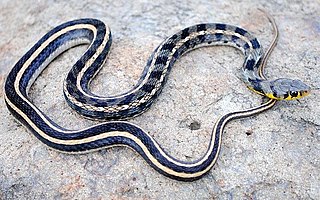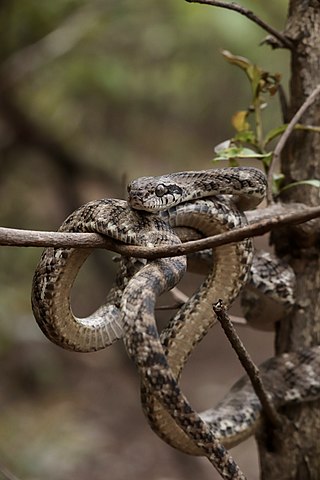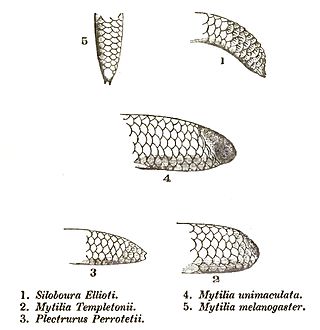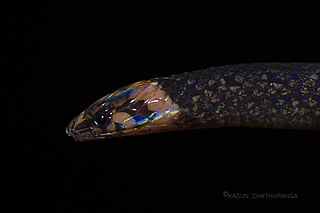
The buff striped keelback is a species of nonvenomous colubrid snake found across Asia. It is a typically non-aggressive snake that feeds on frogs and toads. It belongs to the subfamily Natricinae, and is closely related to water snakes and grass snakes. It resembles an Asian version of the American garter snake. It is quite a common snake but is rarely seen.

Boiga forsteni, also known commonly as Forsten's cat snake, is a species of mildly venomous rear-fanged snake in the family Colubridae. The species is endemic to South Asia.

Dendrelaphis bifrenalis, also called Boulenger's bronzeback, Boulenger's bronze-back, and Travancore bronze-brown snake, is a colubrid snake native to Eastern Ghats of Southern India and Sri Lanka. It was first described by George Albert Boulenger in 1890. Dendrelaphis wickrorum from Sri Lanka was previously confused with this species.

Gerarda prevostiana, commonly known as the cat-eyed water snake, Gerard's water snake, and the glossy marsh snake, is a species of snake in the family Homalopsidae. The species is endemic to Asia. It is the only species in the genus Gerarda.

Rhabdophis plumbicolor, known as the green keelback or lead keelback, is a species of nonvenomous snake in the family Colubridae native to parts of the Indian subcontinent.

The checkered keelback, also known commonly as the Asiatic water snake, is a common species in the subfamily Natricinae of the family Colubridae. The species is endemic to Asia. It is non-venomous.

Sibynophis subpunctatus, commonly known as Duméril's black-headed snake or Jerdon's many-toothed snake, is a species of nonvenomous colubrid snake endemic to Bangladesh, India, Sri Lanka, and Nepal.
St. John's keelback is a species of snake in the subfamily Natricinae of the family Colubridae. The species is endemic to Asia.
Calliophis melanurus, commonly known as the slender coral snake, is a species of venomous elapid snake endemic to the Indian subcontinent. Two subspecies are recognized, including the nominotypical subspecies.

Jerdon's sea snake is a species of venomous sea snake in the subfamily Hydrophiinae.
Hydrophis cantoris, also known commonly as Cantor's narrow-headed sea snake and Cantor's small-headed sea snake, is a species of venomous sea snake in the family Elapidae.

Craspedocephalus trigonocephalus, the Sri Lankan pit viper, Ceylon pit viper, Sri Lankan green pitviper or locally, pala polonga, is a venomous pit viper species endemic to Sri Lanka. No subspecies are currently recognized.

Boiga barnesii is a species of cat snake endemic to Sri Lanka. It is known as Barnes' cat snake in English and panduru mapila-පදුරු මාපිලා in Sinhala. It is a member of the snake family Colubridae. It is distributed in the lowlands and midlands up to approximately 600 m (2,000 ft) above sea level, with known localities include Matale, Kandy, Gannoruwa, Gampola, Ambagamuwa, Balangoda, Labugama and Sinharaja Rain Forest. Barnes' cat snake is mainly a forest-dwelling species but may occasionally be found in human habitats. It is the smallest cat snake in Sri Lanka and grows up to a maximum of about 600 mm (24 in) in snout-vent length. Being a nocturnal and an arboreal hunter, it mainly feeds on agamid lizards and geckos. The day time is usually spent inside a tree hole or a crevice. It’s a very timid and a mildly venomous snake and rarely attempts to bite.

Rhinophis blythii, or Blyth's earth snake, is a species of snake in the family Uropeltidae. The species is endemic to the rain forests and grasslands of Sri Lanka.
Rhabdophis ceylonensis is endemic to the island of Sri Lanka. The species is commonly known as the Sri Lanka blossom krait, the Sri Lanka keelback, and මල් කරවලා or නිහලුවා (nihaluwa) in Sinhala. It is a moderately venomous snake.
Aspidura copei, commonly known as Cope's rough-sided snake or කලු මැඩිල්ලා in Sinhalese, is a species of snake in the family Colubridae. The species is endemic to Sri Lanka.
Aspidura drummondhayi, commonly known as Drummond-Hay's rough-sided snake or කෙටිවල් මැඩිල්ලා in Sinhala, is a species of snake in the family Colubridae. The species is endemic to Sri Lanka.

Aspidura guentheri, commonly known as Günther's rough-sided snake, is a species of snake in the family Colubridae. The species is endemic to Sri Lanka. It is the smallest member of the genus Aspidura.

Fowlea is a genus of snakes in the subfamily Natricinae of the family Colubridae. The genus is endemic to Asia.
Fowlea schnurrenbergeri or Xenochrophis schnurrenbergeri is a species of Non venomous snake in the family Colubridae. It is found in Nepal, Pakistan, India and Bangladesh.














